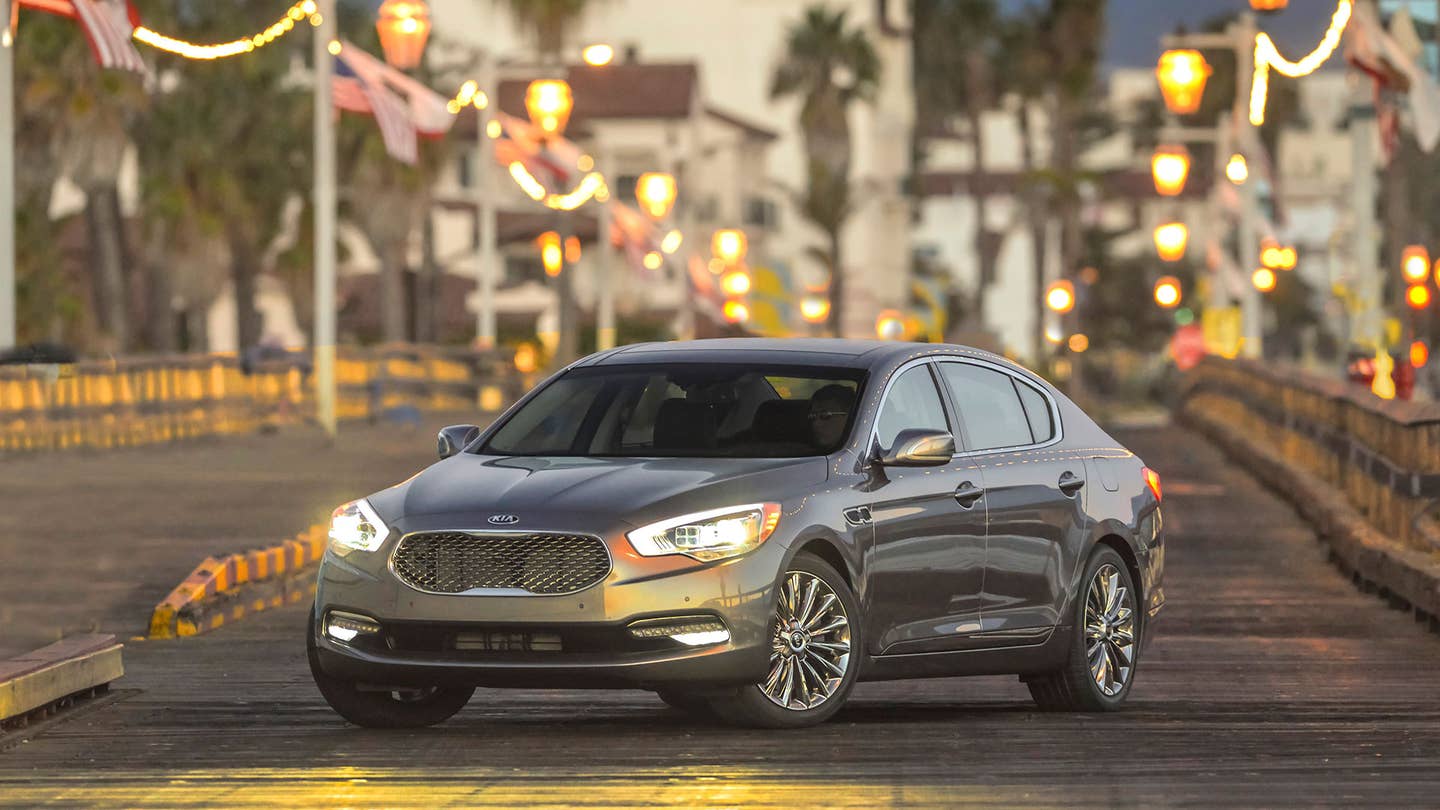Kia’s K900 Is the Fake Rolex of Fullsize Sedans
Especially when fitted with a V6, Kia’s flagship means badge engineering gone horribly wrong.

As it turns out, Kia’s social climbing K900 luxury sedan makes its best impression when it’s buried in snow. Artfully scraping four inches of powder off the K900, I could reveal the German-Xerox sedan body, yet leave the Kia badges obscured. Let onlookers believe I could afford a BMW 7-Series, rather than pity me as a parvenu in a $60,000 Kia.
Strive as it might, the K900 remains the fake Rolex of luxury cars, even if this full-size trinket hails from Korea and not back-alley Chinatown. The addition of a more-affordable V6 model for 2016, at $49,950 to start, just seems to amplify the Kia’s neither-nor status.
I’d parked the K900 at City College of New York in Harlem, a stately neo-gothic campus founded in 1849 on principles that today’s Kia and Hyundai buyers would recognize: A grand experiment in mass democracy, that regular citizens could aspire to institutional quality and value previously reserved for the privileged few.
Hyundai is turning that very idea into brick-and-mortar reality with its new Genesis luxury brand. And the brand’s roughly $40,000 namesake, the impressively Lotus-tuned Genesis sedan, is indeed the kind of bridge-spanning midsize luxury car that tops any current rival from Lincoln, Acura, Infiniti or Buick.
But the K900 remains a bridge too far, soaring as high as $70,000 for the 420-horsepower 5-liter V8 version. On the plus side, the rear-drive Kia looks much better than its ugly-stick sister, the Hyundai Equus. But to get there, the Kia adopts influences like Brad and Angelina adopt orphans, until it resembles one of those weird composites of human faces: The 7-Series’ profile, the Audi-style LED taillamps, the Lexus-like pragmatic cabin. For 2016, the Kia reworks its honeycomb grille and rear bumper, including flush-mounted, parallelogram-shaped exhaust outlets. Yet viewed from 10 yards or 100, the Kia is a second-hand grab bag of ideas and attitudes. Ditto the cabin: Rich materials and fit-and-finish hold up their end, but a blank, nearly lobotomized personality sends the whole illusion crashing down. Hyundai’s Genesis offers more flair for far less money.
The genericism extends to performance, especially with the 3.8-liter V6. Its 311 horsepower and 293 pound-feet of torque sound decent on paper, but this naturally aspirated engine isn’t in the same overachiever’s league as turbo six-cylinders from BMW, Audi, Mercedes or Cadillac. Throw in fatso curb weight that tops 5,300 pounds in loaded V6 trim, and the result is an indifferent 0-60 mph run that we estimate in the mid 6s.
The overtaxed V6 only exacerbates the Kia’s river-barge tendencies. Think the Lexus LS is pillow-soft? The Kia will smother you until your heart flatlines. The steering feels soupy, the chunky body lolls in corners, the front end lunges under hard braking. New paddle shifters for the eight-speed automatic transmission nod to performance, but the little plastic chips weren’t nodding correctly on my test car: The right-hand shifter kept getting stuck, preventing me from manually selecting gears.
For such a big sedan, the Kia is also a space-waster inside. We’re talking a car that stretches 200 inches, nearly eight inches longer than a Honda Accord. Shakira’s hips don’t lie, and neither do our knees: The K900’s 38.2 inches of rear legroom trails the Accord by 0.3 inches.
The upsides are about what you’d expect: The Kia glides over bumps and shushes every noise, and looks to fill the laundry list of a flagship sedan, feature by feature. Even the base V6 model checks off standard leather, navigation and a big panoramic sunroof.
A winter day’s run to New York’s MoMath, the national mathematics museum, had my daughter cooing over the reclining, heated-and-cooled rear seats. That’s part of a $5,000 option package whose features included the class-requisite adaptive cruise control, autonomous emergency braking, and monitors for blind spots, lane departure and rear cross-traffic. Seats are comfortable all around, including an optional powered thigh extender for the driver.
A newly available suite of Uvo Luxury services includes smartphone-enabled remote locking, starting and climate control. The K900 adopts an enlarged, 9.2-inch navigation system; but some functions are clunkier than what we expect from the ergonomically correct Kia and Hyundai, including a virtual keyboard that made for tedious scrolling via a rotary console controller.
Lurk near the trunk with the keyfob in your pocket, and an optional feature automatically pops the boot open after three seconds. It’s perfect for gangsters looking to make deals and keep hands at the ready.
On that theme, Kia would prefer luxury shoppers to see the K900 as some kind of steal. But an icy reception for the 2015 model suggests that Americans won’t be an easy mark, even for this less-costly V6 version. Certainly, luxury cars aren’t always about hoity brand names, as the Genesis’ success has proved. But when prices shoot past $50,000 and $60,000, underdog brands need stronger persuasion in design, performance and price; the offer you can’t refuse. You’d have to hold a gun to our heads to get us into the K900, and not just because it flashes a Kia badge.
